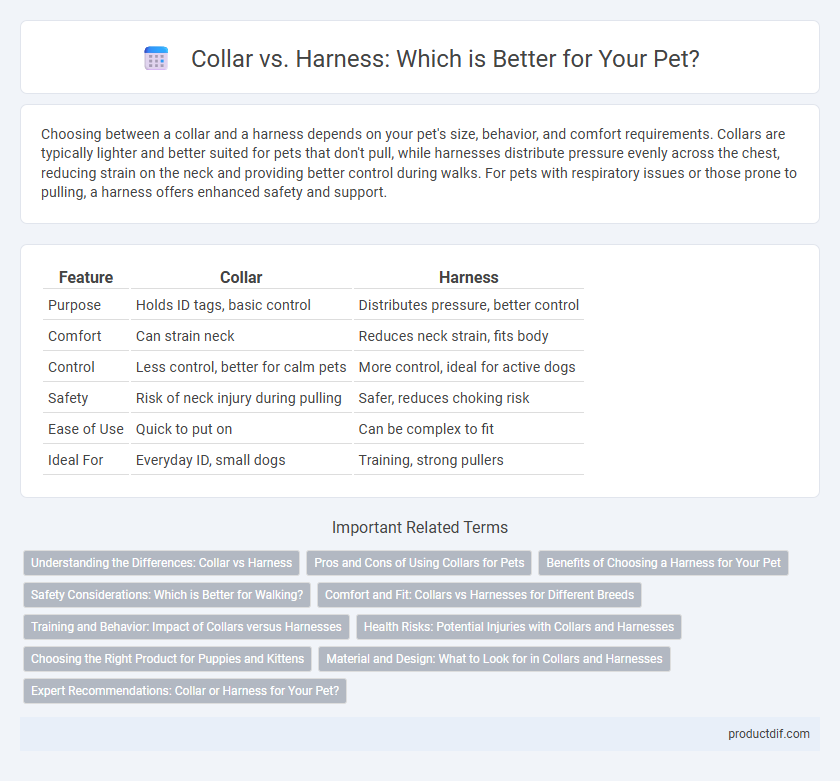Choosing between a collar and a harness depends on your pet's size, behavior, and comfort requirements. Collars are typically lighter and better suited for pets that don't pull, while harnesses distribute pressure evenly across the chest, reducing strain on the neck and providing better control during walks. For pets with respiratory issues or those prone to pulling, a harness offers enhanced safety and support.
Table of Comparison
| Feature | Collar | Harness |
|---|---|---|
| Purpose | Holds ID tags, basic control | Distributes pressure, better control |
| Comfort | Can strain neck | Reduces neck strain, fits body |
| Control | Less control, better for calm pets | More control, ideal for active dogs |
| Safety | Risk of neck injury during pulling | Safer, reduces choking risk |
| Ease of Use | Quick to put on | Can be complex to fit |
| Ideal For | Everyday ID, small dogs | Training, strong pullers |
Understanding the Differences: Collar vs Harness
Collars and harnesses serve distinct purposes in pet care, with collars primarily used for identification and lightweight control while harnesses provide better security and distribute pressure to prevent neck injuries. Harnesses are ideal for pets prone to pulling or with respiratory issues, offering enhanced comfort and safety during walks. Choosing between a collar and harness depends on your pet's size, behavior, and specific medical needs to ensure optimal health and control.
Pros and Cons of Using Collars for Pets
Collars for pets offer lightweight design and ease of use, making them ideal for holding ID tags and quick leash attachment during short walks. However, collars can pose risks such as neck strain or injury if a pet pulls aggressively, especially in small or delicate breeds. Unlike harnesses, collars provide less control over pulling behavior and may not be suitable for pets prone to respiratory issues or those requiring extra support.
Benefits of Choosing a Harness for Your Pet
Choosing a harness over a collar offers superior control and reduces strain on your pet's neck, making it especially beneficial for small breeds and those with respiratory issues. Harnesses distribute pressure evenly across the chest and shoulders, minimizing injury risks during walks or outdoor activities. This design also prevents choking and enables better leash management, enhancing safety and comfort for both pets and owners.
Safety Considerations: Which is Better for Walking?
Harnesses reduce the risk of neck injury by distributing pressure evenly across a dog's chest, making them safer for pets prone to pulling or respiratory issues. Collars pose a higher risk of tracheal damage or choking, especially if a dog suddenly lunges or pulls harshly. For walking safety, harnesses generally provide better control and minimize injury risks compared to collars.
Comfort and Fit: Collars vs Harnesses for Different Breeds
Harnesses provide superior comfort and fit for breeds with delicate necks or respiratory issues, distributing pressure evenly across the chest and shoulders. Collars are often suitable for small or medium-sized breeds with sturdy necks but may cause discomfort or injury if used improperly on breeds with sensitive tracheas. Breed-specific anatomical differences should guide the choice between collar and harness to ensure optimal safety and comfort during walks.
Training and Behavior: Impact of Collars versus Harnesses
Harnesses provide better control during training by distributing pressure evenly across a pet's body, reducing the risk of neck injury and discouraging pulling behavior. Collars may cause discomfort or harm if used improperly, potentially leading to negative associations with training and increased anxiety. Choosing a harness supports calmer, more effective training sessions and promotes positive behavioral development in pets.
Health Risks: Potential Injuries with Collars and Harnesses
Collars can cause tracheal damage, neck strain, and skin irritation if pulled too tightly or used improperly, particularly in small or delicate dog breeds. Harnesses distribute pressure more evenly across the chest and shoulders, reducing the risk of throat injuries but may cause chafing or restrict movement if poorly fitted. Selecting the right size and design is essential to minimize health risks and prevent potential injuries in pets during daily walks.
Choosing the Right Product for Puppies and Kittens
Selecting the right collar or harness for puppies and kittens involves prioritizing comfort, safety, and proper fit to support their growing bodies. Collars are ideal for identification and lightweight control, but harnesses distribute pressure more evenly and reduce strain on delicate necks, making them suitable for active or small breeds. Opt for adjustable, breathable materials with secure fasteners to ensure both security and ease of movement during early training and exploration.
Material and Design: What to Look for in Collars and Harnesses
High-quality collars and harnesses for pets should prioritize durable, non-toxic materials such as reinforced nylon, leather, or breathable mesh to ensure comfort and longevity. Design factors including adjustable straps, secure buckles, and ergonomic shapes contribute to a better fit and prevent chafing or injury. Reflective elements and quick-release mechanisms enhance safety during nighttime walks and emergency situations.
Expert Recommendations: Collar or Harness for Your Pet?
Experts recommend choosing a harness over a collar for pets prone to pulling or with respiratory issues, as harnesses distribute pressure more evenly and reduce neck strain. Collars remain suitable for well-trained pets and essential for ID tags and quick leash attachment. Veterinary and training professionals emphasize selecting gear based on your pet's size, behavior, and health to ensure safety and comfort.
Collar vs Harness Infographic

 productdif.com
productdif.com